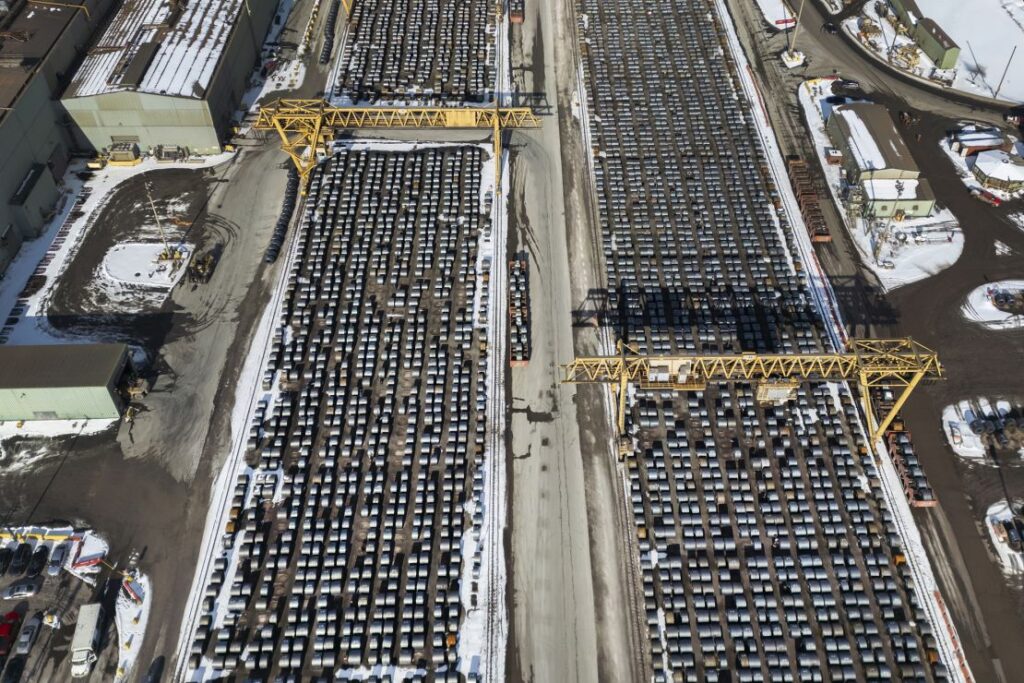Washington, D.C. – The global trade landscape shifted dramatically as former U.S. President Donald Trump imposed a 25% tariff on steel and aluminum imports into the United States on March 12, 2025. The move, aimed at revitalizing domestic manufacturing, has triggered immediate and forceful retaliation from major trading partners Canada and the European Union (EU).
The tariffs apply to all steel and aluminum imports, including those from allies previously exempted in earlier tariff rounds. The new measures are expected to reshape international trade dynamics and have already sparked backlash from industry groups, economists, and U.S. trading partners.
Canada and EU Retaliate with Billions in Counter-Tariffs
Within hours of the U.S. tariff announcement, Canada and the European Union announced retaliatory measures aimed at counterbalancing the economic impact of the new trade restrictions.
- Canada’s Response: The Canadian government imposed “dollar-for-dollar” counter-tariffs worth $21 billion, targeting U.S. steel, aluminum, consumer electronics, and sporting goods. Canadian officials argue that the U.S. tariffs violate free trade agreements, further straining relations between the two North American allies.
- European Union’s Response: The European Union introduced $28 billion worth of retaliatory tariffs on American goods, including iconic U.S. exports such as bourbon, motorcycles, and agricultural products. EU officials have condemned the U.S. tariffs as “protectionist” and “harmful to global trade.” (European Commission Trade Policies)
Both Canada and the EU have signaled they may escalate trade measures further if the U.S. does not reverse the decision.

What Led to Trump’s Decision?
Trump has long championed protectionist policies, arguing that foreign steel and aluminum imports hurt American workers and industries. According to the former president, the tariffs will encourage domestic production and reduce reliance on foreign materials, particularly from China, Mexico, and Europe.
“For decades, America has been taken advantage of. We are bringing back jobs and protecting American manufacturers,” Trump stated at a press conference announcing the tariffs.
However, trade experts and industry leaders warn that the tariffs could backfire by increasing costs for American businesses that rely on steel and aluminum for production. Major U.S. industries—including automobile, aerospace, and construction—fear rising costs could lead to job losses and economic slowdowns.
Impact on the Global Economy and Consumers
The decision to impose tariffs has already caused market disruptions, with investors worrying about an escalating trade war.
- Stock Market Reactions: Markets reacted negatively to the news, with Dow Jones Industrial Average dropping 500 points following the announcement.
- Price Increases: Consumers may face higher prices for goods such as cars, appliances, canned food, and electronics.
- Impact on American Manufacturers: While some U.S. steel and aluminum producers may benefit, industries that depend on imported materials could struggle with increased costs.
Global trade analysts warn that prolonged tariff conflicts could result in billions of dollars in lost trade and economic instability.
How Other Countries Are Responding
While Canada and the EU have acted swiftly, other U.S. trading partners may soon follow suit.
- China: Although not specifically targeted, China has condemned the U.S. move and is reportedly considering its own countermeasures.
- Japan: Japan has voiced concerns that the tariffs will damage supply chains in the auto and electronics industries.
- Mexico: Mexico is also reviewing its trade policies and may retaliate with tariffs on American agricultural goods.
Trade organizations, including the World Trade Organization (WTO) and the International Monetary Fund (IMF), have expressed concerns that such tariffs violate global trade agreements and could lead to widespread economic instability. (World Trade Organization, International Monetary Fund)
What Happens Next?
The tariffs are expected to face legal challenges at the World Trade Organization (WTO), where Canada and the EU are likely to file formal disputes. Additionally, U.S. lawmakers and business groups are lobbying against the tariffs, warning of their economic consequences.
Experts predict that unless diplomatic negotiations resolve the trade tensions, the U.S. may face an extended trade war that could harm international economic growth and American businesses.
In the coming weeks, further retaliatory measures could be announced as global leaders determine their next course of action.

For more updates on this developing story, visit the following sources:
- United States Trade Representative (USTR)
- U.S. Department of Commerce – Tariff Information
- European Commission Trade Department
Conclusion
The global trade conflict is intensifying as Trump’s 25% tariffs on steel and aluminum provoke swift retaliation from Canada and the EU. With billions of dollars at stake and economic risks mounting, the international community watches closely for diplomatic resolutions or further escalation.
This is a developing story—stay tuned for updates on how this trade war unfolds.
This article has been carefully fact-checked by our editorial team to ensure accuracy and eliminate any misleading information. We are committed to maintaining the highest standards of integrity in our content.

A senior at Yale-NUS College with interests in developmental and labour economics, as well as creative non-fiction and poetry. Currently, I’m studying as an Economics major and an Arts and Humanities minor (focusing on Creative Writing) with heavy involvement in the Singaporean journalism scene and involved in research on economic history and educational policy. I’m working as an author for SKC News, Yale-NUS’ student publication, as a writer for Wingspan, Yale-NUS’ alumni magazine, and as a tutor for the NUS Libraries Writer’s Centre. | Linkedin



